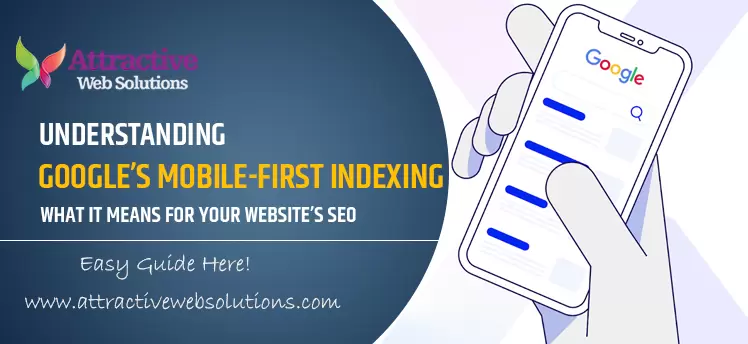In recent years, Google has transformed its approach to website indexing by introducing a new standard: mobile-first indexing. With the rapid growth of mobile users, Google’s mobile-first indexing has become essential for SEO. If you’re not familiar with this concept, or you’re unsure how it impacts your website, you’re in the right place. In this guide, Attractive Web Solutions will explain what mobile-first indexing is, why it matters, and how you can optimize your website for better rankings on Google’s search engine.
What is Mobile-First Indexing?
At its core, mobile-first indexing means that Google primarily uses the mobile version of a website for indexing and ranking in its search engine results pages (SERPs). Traditionally, Google evaluated and ranked a website based on its desktop version. But with the shift in user behavior towards mobile browsing, Google now assesses the mobile version of websites as the primary content source.
So, when we talk about mobile-first Google standards, we’re referring to a search engine algorithm that considers the mobile experience of a website before anything else.
Why Did Google Introduce Mobile-First Indexing?
Google introduced mobile-first indexing because of the substantial increase in mobile internet usage. Mobile users are now the majority online, with billions of searches happening on smartphones every day. Google adapted to this change by developing mobile-first indexing to enhance the mobile user experience and ensure that search results are more relevant for the modern user.
Key reasons for mobile-first indexing:
- Changing User Behavior: With more than half of global web traffic coming from mobile devices, it was clear that a shift was necessary.
- Better User Experience (UX): Google’s ultimate goal is to provide users with relevant content that’s easy to access. By focusing on mobile-friendly sites, Google aims to improve the user experience.
- Improved Performance and Accessibility: Mobile-first sites load faster, perform better, and often include adaptive designs, enhancing accessibility.
How Does Google’s Mobile-First Indexing Work?
With mobile-first indexing, Google uses bots or “crawlers” to analyze the mobile version of your website instead of the desktop version. If your website has both a desktop and a mobile version, Google will focus on the mobile one for ranking purposes.
This shift to Google mobile first indexing means that webmasters and businesses must pay extra attention to the mobile experience of their sites. If the mobile version of a site lacks content, is difficult to navigate, or doesn’t function as well as the desktop version, it could suffer in search rankings.
Important Aspects of Google’s Mobile-First Indexing:
- Mobile Version Takes Priority: The mobile version is the primary source for indexing, which impacts how search rankings are determined.
- Responsive and Adaptive Sites Are Beneficial: Responsive designs, which adapt automatically to different screen sizes, generally perform better under mobile-first indexing.
- Unified Indexing System: Google still has a single index, but it now prioritizes mobile-first content.
How to Optimize Your Site for Mobile-First Indexing
To succeed under Google’s mobile-first indexing, you need to ensure that your mobile site is just as optimized, informative, and user-friendly as the desktop version. Here are some best practices to get your site ready:
1. Ensure Content Consistency Across Mobile and Desktop
It’s essential that your mobile version of the site contains the same core content as the desktop version. Many websites used to “hide” content on their mobile sites, but with mobile-first indexing, this can hurt your SEO. Make sure that text, images, and videos on the desktop version are also accessible on mobile.
2. Use a Responsive Design
One of the most effective ways to prepare for Google mobile-first indexing is by adopting a responsive design. A responsive website automatically adjusts its layout and content based on the screen size, which improves usability on all devices. Google recommends responsive web design as it provides a consistent experience for both mobile and desktop users.
3. Optimize Page Load Speed
Page load speed is crucial for both SEO and user experience. Slow loading times are particularly detrimental to mobile users, who often expect quick access to content. You can enhance load speed by:
- Compressing images.
- Minimizing CSS and JavaScript files.
- Leveraging browser caching.
- Using Accelerated Mobile Pages (AMP) to improve mobile performance.
4. Optimize for User Experience (UX)
Mobile-first indexing isn’t just about making sure your site displays on a small screen; it’s about creating an easy and enjoyable experience. This means:
- Avoiding pop-ups that cover content.
- Making buttons and links large enough to be clicked easily.
- Using readable font sizes.
- Ensuring navigation is straightforward and intuitive.
5. Ensure Proper Mobile SEO Practices
Mobile-first indexing Google standards also require that your mobile SEO is on point. This means:
- Meta Tags: Use consistent meta tags on both desktop and mobile versions.
- Structured Data: Ensure that structured data markup on your mobile site matches the desktop version, so Google accurately interprets your content.
- Internal Linking: Maintain a clear internal linking structure on mobile to help Google and users navigate your site.
Common Mistakes to Avoid with Mobile-First Indexing
1. Content Hiding on Mobile
One of the most common mistakes is hiding valuable content on the mobile version. Google now looks at the mobile site as the primary source for indexing, so if content is missing on mobile, it may be ignored in the search results.
2. Neglecting Mobile Load Speed
Mobile users expect fast loading times, and Google mobile first indexing emphasizes the importance of page speed. If your site is slow on mobile, users may leave, increasing bounce rates and hurting rankings.
3. Ignoring Mobile-Optimized Images and Videos
Images and videos should be responsive, load quickly, and not disrupt the user experience. Heavy or improperly optimized media files can slow down your site and affect its performance under mobile-first indexing.
Why Mobile-First Indexing Matters for Your SEO Strategy
Understanding mobile-first indexing Google standards is essential for developing a successful SEO strategy. Here’s how mobile-first indexing can impact your site’s SEO:
- Higher Rankings on Mobile-Friendly Sites: Since Google now assesses sites based on their mobile versions, mobile-friendly sites are more likely to rank higher than those that aren’t optimized for mobile.
- Reduced Bounce Rates: A mobile-friendly site keeps users engaged, reducing bounce rates and signaling to Google that your content is valuable.
- Increased User Engagement: A responsive, easy-to-navigate site is more likely to keep users on the page, boosting dwell time and improving SEO metrics.
- Increased Competitiveness: In a digital landscape where many websites are still adjusting to mobile-first indexing, a fully optimized mobile site can give you an edge over competitors who haven’t adapted.
How Mobile-First Indexing Affects Different Types of Websites
1. E-commerce Websites
Mobile shopping is more popular than ever, and for e-commerce sites, mobile-first indexing is critical. A mobile-friendly shopping experience can lead to higher conversions, better customer satisfaction, and improved SEO.
2. Content Websites (Blogs, News, etc.)
For content-heavy websites, ensuring that articles, images, and videos are mobile-optimized is essential. If users struggle to read or access content, it will impact bounce rates and time-on-site metrics, hurting rankings.
3. Service-Based Business Websites
Service-based websites often rely on leads from mobile users. If potential customers can’t easily find or contact a business on mobile, they may look elsewhere, affecting both conversions and SEO.
The Future of Mobile-First Indexing and Google’s Search Landscape
As Google continues to prioritize mobile, mobile-first indexing will become the universal standard. Some trends we may see include:
- Increased Importance of Page Experience Metrics: Google’s focus on Core Web Vitals, such as page speed and interactivity, will continue to grow, making mobile optimization more crucial.
- More Adaptive and Responsive Technologies: New tools and technologies will emerge to help websites adapt seamlessly across devices.
- Shift to Mobile-First Content Creation: Websites will increasingly create content specifically with mobile in mind, including shorter paragraphs, visuals that load quickly, and interactive elements optimized for touchscreens.
For website owners, staying ahead of these trends and adhering to mobile-first Google practices will be essential for long-term SEO success.
Read Also: Why Your Business Needs a Mobile-First Website Design
Final Thoughts
Google’s shift to mobile-first indexing reflects the changing nature of web usage and the rise of mobile users. For businesses and website owners, adapting to Google’s mobile-first indexing standards is no longer optional—it’s essential for staying competitive, improving SEO, and delivering a quality user experience.
At Attractive Web Solutions, we help our clients navigate these changes by providing mobile-friendly web design and digital marketing strategies that align with mobile-first indexing Google standards. Our team is dedicated to helping you create a mobile-optimized website that improves rankings, engagement, and customer satisfaction.









0 Comments